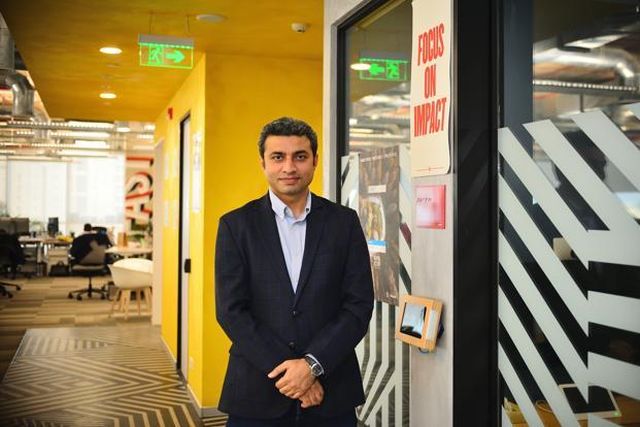
by Editor | May 25, 2021 | Business, Markets, Medium Enterprise, Networking, Technology
 By Nishant Arora,
By Nishant Arora,
New Delhi : As the European Union (EU) gets ready to implement the much-awaited General Data Protection Regulation (GDPR) to harmonise data privacy laws for its citizens from May 25, most of the Indian organisations are still grappling to comply with the stringent regulation.
Containing 99 articles and 173 recitals, GDPR has key requirements that directly impact the way organisations implement IT security, thus addressing the key security tenets of confidentiality, integrity and availability of data.
According to the latest forensic data analytics survey by Ernst & Young (EY), only 13 per cent of the Indian firms have a plan to comply with GDPR by May 25.
As India is not present in the list of countries approved for data portability and transfer, GDPR poses an extra challenge for domestic firms that operate in the EU.
“It is imperative for Indian firms to plan and continue their journey towards compliance even after May 25, to ensure continuity of business within the EU and avoid hefty penalties because of non-compliance,” Jaspreet Singh, Partner-Cyber Security, EY, told IANS.
For Ramesh Vantipalli, Director Systems Engineering, End User Computing, VMware India, the challenge for the Indian organisations facing the GDPR is ubiquitous data which will only increase exponentially in future.
“For Indian companies with operations in the EU, data security measures will now have to work alongside legal and compliance teams to ensure maximum adherence to GDPR,” Vantipalli told IANS.
“Fortunately, the transition will take place over some time and not overnight, giving Indian companies enough time to get their GDPR strategy in place,” he added.
With data privacy concerns on the rise and stringent regulatory requirements like GDPR coming into force, organisations have no choice but to redefine the way they approach data management.
“Organisations should realise that GDPR is about more than just data; it’s necessitating a new playbook for businesses to engage with people,” stressed Akshay Aggarwal, Director, Solution Specialist, Oracle India.
Non-compliance with GDPR can result in heavy fines and increased regulatory actions.
“Organisations that collect personal data must be able to prove that they consistently and reliably comply with GDPR privacy and security principles. We’re actively working with several Indian businesses in this regard,” Aggarwal told IANS.
A new study from IBM reveals that nearly 60 per cent of organisations surveyed are embracing the GDPR globally as an opportunity to improve privacy, security, data management or as catalyst for new business models, rather than simply a compliance issue or impediment.
GDPR is a fairly complex piece of legislation with far reaching impact not just within the EU but across the world.
“Indian companies operating in the EU will have to change the way they capture, process and use data of EU nationals. It is a complicated process involving in-depth understanding of privacy laws and policies,” said Prajit Nair, Director Sales-End User Computing, VMware India.
Technology alone cannot help organisations understand and transition to GDPR, but it will be a crucial enabler.
“Indian companies must put in place a comprehensive strategy involving legal, compliance and IT departments to ensure complete adherence to the GDPR laws, as well as a proactive plan to address breaches and leaks,” Nair told IANS.
In fact, the post-GDPR world will see a much closer integration of the law and technology as organisations work out their data protection strategies.
According to George Chang, Vice President-APAC of cyber-security firm Forcepoint, India’s Data Protection Law, when comes into effect, will sure have a major impact on business operations.
“Organisations in India need to place compliance and data security as a priority considering the cost for violating these privacy laws is about to get very expensive. GDPR can cost up to 20 million Euros or 4 per cent of annual turnover, whichever is higher, for intentional or negligent violations,” Chang informed.
“With those kinds of stakes, investing in compliance now is the only right move for a sustainable business model,” he added.
According to Richard Hogg, Global GDPR and Governance Offerings Evangelist, IBM, GDPR applies to all the personal data of any employee or customer who are in Europe.
“Whether they are citizens or temporary residences and live there, are just passing through an EU airport for 30 minutes. During this time, potentially GDPR applies to their personal data.
“GDPR really does have extra-territorial scope. Additionally, it can apply to anyone’s personal data, if you are actively marketing or profiling them From Europe, wherever they are in the world,” Hogg told IANS.
As the clock ticks down to the deadline to comply with the new GDPR regulations, the Indian firms need to enact strict data protection regulations.
“With strong data protection strategies in place, customers will place greater confidence in businesses, and businesses will minimise the financial fall-out of a breach,” Chang told IANS.
(Nishant Arora can be contacted at nishant.a@ians.in)
—IANS

by Editor | May 25, 2021 | Interviews, Markets, Networking, Social Media, Technology

Sandeep Bhushan, Director, Facebook India and South Asia
By Nishant Arora,
Gurugram (Haryana) : When we talk about advertising potential on Facebook, the fact is that 2.2 billion global users — almost a quarter of the world’s population — constitute the largest marketplace on Earth that can be explored better with intelligent communication and targeted, age-specific outreach.
Facebook India has done its homework and has real, contemporary data based on primary research and insights survey on how Indians, especially millennials, are shopping on smartphones and still, many fall off the grid and cancel orders in the middle of their purchase journey.
In India, there are nearly 380 million smartphone users as of today, according to Counterpoint Research.
The number of Internet users in India will reach 500 million by June, says a joint report by The Internet and Mobile Association of India (IAMAI) and Kantar IMRB. On the other hand, the mobile phone customer base now stands at over 1.17 billion, according to the Telecom Regulatory Authority of India (TRAI).
Facebook today has 217 million users in India — a huge market to tap into and advertisers know this well — and are aware of the future too when seven in 10 smartphone purchases will be mobile influenced by 2022.
“We now have reliable data how people are buying on smartphones. We can make their path to purchase smooth, make those quickers reduce friction, increase sales and cut costs for businesses,” Sandeep Bhushan, Director, Facebook India and South Asia, told IANS in an interview.
“We are mapping the friction and planning products and tools for businesses to reduce the friction and, therefore, can provide greater value for businesses and consumers alike in a secure way,” Bhushan added.
Currently, mobile influences 58 per cent of smartphone purchase decisions, amounting to $8.5 billion worth of sales and it is expected to grow 1.8 times to reach 73 per cent and influence $15.6 billion worth of sales by 2022, according to a joint Facebook-KPMG report.
Facebook influences 33 per cent of purchase decisions amounting to $4.8 billion worth of sales and it is expected to grow two times to reach 44 per cent and influence $9.5 billion worth of sales by 2022.
According to Bhushan, Facebook is ready to help smartphone brands reduce the consumer drop-off from their purchase journey, creating $3.1 billion worth of potential revenue for them by 2022.
“We can reduce purchase time by 14 odd per cent. We also know that sales can go by up to $3 billion, built on the fact that consumers will use mobiles for various purposes and the device offers all kinds of possibilities. We can do right messaging at the right place with mobile and cut the friction,” Bhushan informed.
After facing the Cambridge Analytica data scandal, Facebook recently cleared that it does not tell advertisers who you are or sell your information to anyone.
“We provide advertisers with reports about the kinds of people seeing their ads and how their ads are performing, but we don’t share information that personally identifies you. You can always see the ‘interests’ assigned to you in your ad preferences, and if you want, remove them,” Rob Goldman, Vice President, Ads at Facebook, wrote recently in a blog post.
Facebook’s mobile advertising revenue represented approximately 91 per cent of advertising revenue for the first quarter of 2018 — up from approximately 85 per cent of advertising revenue in the first quarter of 2017.
“We understand that consumers are different — men, women, young, old, affluent and non-affluent — and have different purchasing patterns. Businesses can reach the right audience on Facebook where they can target by age.
“Consumers below age 25 are more tech-savvy; so businesses can provide them with deeper, technical information about a product. For consumers like me, all I need to know is my favourite brand has a new feature or not. This is what we do — simplify the path to purchase,” Bhushan told IANS.
To take the vision closer to reality, Facebook is already running a programme with one big smartphone player.
“In this programme, the moment you see an ad, you click, the lead form opens, auto populates, you click again and get a call from the promotor of the retail store next to you within an hour,” the Facebook India executive informed.
“We have interesting, intelligent forms which are auto-filled that gives customers flexibility and mental peace. All of this was not possible earlier,” Bhushan told IANS.
The data lets advertisers reach the right people, including millions of small businesses, who rely on Facebook every day to reach people who might be interested in their product.
“We are ready for products in any Internet situation. 2G is still default in India despite so much 4G talk as there are more mobile handset users that smartphone ones; so we have covered them too with Facebook Lite,” Bhushan stressed.
(Nishant Arora can be contacted at nishant.a@ians.in)
—IANS

by Editor | May 25, 2021 | Business, Corporate, Corporate Buzz, Corporate Governance, Markets, Medium Enterprise, SMEs, Technology
 By Nishant Arora,
By Nishant Arora,
Seattle (Washington) : While the Artificial Intelligence (AI) technology is making its presence felt across the spectrum globally, India needs to prioritise AI-based predictive analysis to improve outcomes in three core areas — agriculture, healthcare and education, a top Microsoft executive has emphasised.
The initial results in India are promising and if deployed at big scale, AI-based models can help farmers, doctors and educators keep building success stories, Joseph Sirosh, Corporate Vice President of Cloud AI Platform at Microsoft, told IANS here.
“For example, AI can help us foresee signs of a student being at risk of dropping out. We have done first such experiment in Andhra Pradesh involving thousands of students,” Sirosh informed.
In 2017, the Andhra Pradesh government expanded the rollout of the experiment to all 13 districts in the state.
In Visakhapatnam district, an application powered by Azure Cloud Machine Learning (ML) processed the data pertaining to all students — based on parameters such as gender, socio-economic demographics, academic performance, school infrastructure and teacher skills — to find predictive patterns.
The results showed that some of the factors leading to students dropping out were insufficient furniture, inadequate toilet infrastructure, etc.
Based on these results, the state government identified about 19,500 probable dropouts from government schools in Visakhapatnam district in the next academic year (2018-19).
“Not just India, AI-based predictive analysis has also helped Tacoma School District here in Washington state improve graduation rate from under 60 per cent to over 83 per cent by managing dropouts,” Sirosh noted.
When it comes to agriculture, Microsoft, in collaboration with the non-profit International Crop Research Institute for the Semi-Arid Tropics (ICRISAT), has developed an AI-sowing app for farmers in India.
The tech giant is using AI and historic weather data to predict the best time for sowing seeds and other stages of the farming process, and pass on that information to farmers via SMS.
“We have done some amazing work, like informing farmers when to sow crops, what is the best time to plant crops during the year, etc. The result is 30 per cent more yield,” Sirosh told IANS.
The farmers do not need to install any sensors in their fields or incur any capital expenditure. All they need is a mobile phone capable of receiving text messages.
To determine the optimal sowing period, the Moisture Adequacy Index (MAI) is calculated. MAI is the standardised measure used for assessing the degree of adequacy of rainfall and soil moisture to meet the potential water requirement of crops.
The data then is downscaled to build predictability and guide farmers to pick the ideal sowing week.
According to Microsoft, ICRISAT has scaled sowing insights in 2018 to 4,000 farmers across Andhra Pradesh and Karnataka for the Kharif crop cycle (rainy season).
“We have made AI-based applications very simple for common people to comprehend. They don’t need to be tech-sophisticated. We have simplified the technology for the end-users,” Sirosh added.
The company has also developed a multi-variate agricultural commodity price forecasting model to predict future commodity arrival and the corresponding prices.
The model uses remote sensing data from geostationary satellite images to predict crop yields through every stage of farming.
According to the company, the model, currently being used to predict the prices of “tur” pulse, is scalable and can be generalised to other regions and crops.
On the health front, the Telangana government has adopted Microsoft Intelligent Network for Eyecare (MINE), which was developed in partnership with Hyderabad-based LV Prasad Eye Institute.
MINE uses ML and advanced analytics to predict regression rates for eye operations, enabling doctors to pinpoint the procedures needed to prevent and treat visual impairments.
“Under the MINE global consortium, we have built AI models that are very accurate for eyecare, especially for children,” Sirosh said.
The Telangana government is using Microsoft’s Cloud-based advanced analytics solution to screen children from birth to 18 years of age for major conditions affecting their health.
“We are also working hard to improve citizen services in India by creating user-friendly application programming interfaces (APIs) for enhanced speech recognition and translation solutions,” Sirosh added.
People are just starting to understand the power of AI-enabled Cloud in India.
“Our partners like TCS, Wipro, Infosys, Cognizant and Accenture are leaning in and adopting AI. These are exciting times for AI and its real adoption in the country,” Sirosh said.
(Nishant Arora was in Seattle on an invitation from Microsoft. He can be reached at nishant.a@ians.in)
—IANS

by Editor | May 25, 2021 | Branding, Business, Large Enterprise, Marketing Basics, Markets, Technology
 By Nishant Arora,
By Nishant Arora,
New Delhi : In the ever-evolving world of smartphones, a few mobile handset makers have been tempted to launch two or even multiple brands in order to gain a larger chunk of the market or create a presence across price segments.
The approach has so far worked in some countries — like in China — but when it comes to India, the dual-brand strategy hasn’t been fruitful till date and has, in fact, affected the vendors’ long-term goals.
Let us look at two big Chinese vendors — Lenovo-Motorola and Huawei-Honor — who have gambled on this strategy in India.
Lenovo’s smartphone shipments in India were just short of a million units, falling by more than 60 per cent (year-on-year) in the first quarter of 2018, according to Hong Kong-based Counterpoint Research.
The last Lenovo-branded smartphone that arrived in India was Lenovo K8 Plus in September 2017. Since then, there has not been any Lenovo-branded device in sight.
Motorola, which has a better visibility and brand value, has seen Moto devices being launched at regular intervals. Motorola Mobility is strengthening its retail presence pan-India with opening more and more “Moto Hubs”.
Meanwhile, Huawei’s sub-brand Honor entered the list of top five most-selling smartphone brands in India for the very first time in the first quarter of 2018. Honor registered a 146 per cent growth in the last quarter.
Sensing newer opportunities, Huawei has now brought its premium smartphone “P20 Pro” to the country for Rs 64,999.
However, its earlier avatar, Huawei P10, never made it to India. The last ‘P’ series device that arrived in the country was “P9” in 2016. Since then, Huawei has been promoting its sub-brand Honor.
The companies are yet to accept the ground reality but the fact is that the Indian consumers are not ready to accept dual brands from one vendor.
“The dual-brand strategy is working fine for Huawei in China. However, we do not have any such success story in India so far,” Jaipal Singh, Senior Market Analyst, IDC India, told IANS.
“That the Lenovo group is gradually decreasing its dependency on the Lenovo brand in India is evident from the fact that most of the devices shipped in India in Q1 2018 were Motorola, which enjoys stronger brand recall in India among both consumers and channels,” Singh noted.
According to Counterpoint Research’s Q1 2018 report, Lenovo and Motorola were out of the top-five vendors’ list in India after a long time.
“The dual-brand strategy is not working for Lenovo-Motorola in India as they have brought devices in almost similar price range, overlapping the positioning in the market,” Tarun Pathak, Associate Director at Counterpoint, told IANS.
Having two brands makes sense if there is some clear demarcation aligned.
“Somewhere, the messaging about Motorola being the choice of evolved users has diminished prospects for Lenovo. Which user will concede that s/he isn’t an evolved one, hence go for Lenovo?,” said Faisal Kawoosa, Head-New Initiatives, CyberMedia Research (CMR).
Retailers had a strong association with Motorola in the initial days of mobile revolution a decade and a half back and are still interested to work with the brand.
“Lenovo’s decision to bet more on Motorola can work in its favour in the long run because Lenovo’s positioning was primarily around aggressive pricing, which has weakened in the past few quarters owing to brands like Xiaomi,” Singh noted.
According to Kawoosa, it is better for Lenovo to go for a single brand in India and, in that case, “Motorola is any time preferred. They can however, always message something like ‘A Lenovo Brand.'”
In fact, the two-brand strategy hasn’t worked for any player in the country.
“We have Lava-Xolo and Micromax-Yu as examples. Without a brand having a convincing reason to exist, it’s better to have just single brand in the interests of simplicity,” Kawoosa told IANS.
Nick Reynolds, Chief Marketing Officer of Lenovo, told IANS during the Consumer Electronics Show (CES) 2018 in January this year that dual-brand strategy of the company would be decided by the customer.
“If the Indian customer views Moto as a premier product, we will position it as such. But if the Indian customer looks for better priced product, our strategy would be to use Lenovo as brand name,” Reynolds told the visiting IANS jounralist.
According to Pathak, Lenovo has a good opportunity to leverage Motorola’s brand and enter new price segments.
“But lately, most of their sales were from sub-$150 segment for both the brands. Hence, it needs to refresh Motorola’s “G” series and target the market again with a multi-channel retail strategy,” Pathak suggested.
Honor, on the other hand, has launched a bunch of smartphones in the last two quarters with several mid-range options like Honor 9 Lite and Honor 7X. The variety and affordable pricing have helped the company enter the top-five list for the first time in Q1 2018.
What applies to Lenovo is true for Huawei too to keep pace with the changing dynamics of the Indian smartphone market.
(Nishant Arora can be contacted at nishant.a@ians.in )
—IANS

by Editor | May 25, 2021 | Branding, Marketing Basics, Markets, Online Marketing, Social Media, Technology
 By Nishant Arora,
By Nishant Arora,
New Delhi : As the millennials in India constantly strive to click that “wow” moment and instantly share it with friends on social media, Artificial Intelligence (AI)-enabled cameras with “minds of their own” are the future that will create perfect shots for them, a top Canon executive has emphasised.
Cameras have become intelligent in the past few years with integrated capabilities like smarter chips, Wi-Fi support, smart functions, better speed and enhanced performance.
“We are on the right path when it comes to infusing AI into cameras. The experience of the last 80 years has helped us catch new trends early — be it in chips, designs, smart functions or controls. Software development is the key to stay ahead,” Kazutada Kobayashi, President and CEO, Canon India, told IANS.
Sensing the future of AI-enabled cameras, Google has launched “Clips” — a camera that uses AI to figure out when it should take a picture or video.
The clip-on camera automatically adjusts its resolution according to the situation and has a 130-degree lens to fit more of the scene in the frame. When it senses something memorable around, it clicks a 15-second-burst photograph.
Canon India has also launched “EOS M50” — a new mirrorless camera for the youth that houses the “DIGIC 8” image processor to ensure better picture quality and comes with 4K movie shooting capability.
According to Kobayashi, camera-centric smartphones are giving the company a renewed push to come up with “serious” cameras as India is an evolving market and so are the demands and expectations of the customers.
“The relationship between a smartphone camera and a real camera is interesting. With smartphones, more and more people are now clicking pictures which have given us a thrust as people are now keen to have better image quality with AI embedded into it. This is a good takeaway from the smartphone market to build Next-Gen cameras,” Kobayashi added.
Canon is bullish on the imaging technology being a carrier for the Internet of Things (IoT) industry that is growing exponentially in India.
“IoT is the future of the connected devices and systems around us. Canon has capabilities like the entry of optical information via camera lens or data analytics via microprocessors. Camera is a very strong entry point to gather information, process and digitise it, and get the desired output. Camera will provide an edge for all IoT devices in the future,” the Canon executive noted.
On a question whether Canon will also begin manufacturing in India, Kobayashi said: “India has a high potential for manufacturing. We have made visits to prospective venues and done feasibility assessments. We don’t have concrete plans as of now to share on bringing a certain product range for manufacturing into the country but yes, we are certainly looking into this”.
The Indian camera market is growing in both the B2B and B2C segments for Canon.
“The impact of demonetisation and GST are now settled and people are ready to spend more money on cameras. I keep my fingers crossed for the second half of this year when the festive season begins. In the B2B segment, we achieved double-digit growth last year and expect to repeat the performance this year too,” Kobayashi added.
(Nishant Arora can be contacted at nishant.a@ians.in)
—IANS





